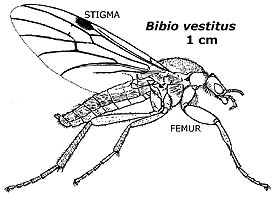
BUG OF THE MONTH: April 1994
March Flies, Family Bibionidae
Copyright © 1994 by Louise Kulzer
This article originally appeared in Scarabogram, April 1994, New Series No. 168, p. 2.
Ever notice that in early spring, the east side of your house suddenly gets visited by a whole hoarde of small, dark, hairy, rather slow, dull-witted flies with big heads? If there weren't so many, you could easily grab the swatter and eliminate them, since they seem more interested in crawling on you than flying away.
Well, if this sounds familiar, there's a good chance you've encountered March
flies. The way to tell for sure is to notice whether 1) the antennae have 6
or more freely jointed segments, but are shorter than the thorax (they should
be); 2) whether there are ocelli (there should be); and 3) whether there is
a V-shaped suture between the prothorax and mesothorax (there shouldn't be)
(Bland & Jacques 1978). The wings are clear with a yellowish brown stigma
(spot) and veins.
Swan and Papp (1972) say they have a distinctive head - longer and narrower in the female (as in figure, right) (I guess this means the male head is short and squat). Regardless, the head of the male is almost entirely occupied by enormous eyes, which are divided into two parts (this is in addition to the ocelli, remember). Good reason for a stockier head, I'd say.
Besides having distinctive heads, March flies have large apical spurs on the tibiae. I've never heard them jingle, jangle, jingle though. In fact, I've never heard March flies make any noise at all. They just silently crawl around stuff, seemingly oblivious of humans. If I may be unscientific, this trait gives me the creeps. I like an engaging fly who buzzes off just as I'm about to slap it for biting me.
Female March flies dig burrows into which they deposit a mass of 200-300 eggs, then die soon after. The larvae are 12-segmented, yellowish with darker spiracles and a shiny brown head. They are primarily scavengers, feeding on decaying organic matter. Some have been reported to enter potatoes damaged by wireworms, as well as other crops (Swan & Papp).
Adults are attracted to flowers and may be important pollinators. In my yard they are attracted to my house and to me. Like I say, they're a bit dull for a fly. But what they lack in wits they make up for in evolutionary strategy. March fly adults emerge very early in spring, before there are many predators about. And they emerge en masse, making it really easy to find each other. They mate, lay eggs, and die before the competition really gets going. And each March they once again prove how successful this strategy can be.
[Six genera and at least 50 species of March flies are listed from western North America. Some Washington species include Dilophus tibialis, Bibiodes aestivus, and Bibio tristis. Some species have brilliantly marked legs, as in Bibio femoratus where each leg femur is a contrasting red. --editor]
References
Bland, Roger G., & H.E. Jacques. 1978. How to know the insects. Wm. C. Brown Co. Publishers.
Swan, Lester A., & Charles S. Papp. 1972. The common insects of North America. Harper & Row.
This page last updated 16 June, 2005